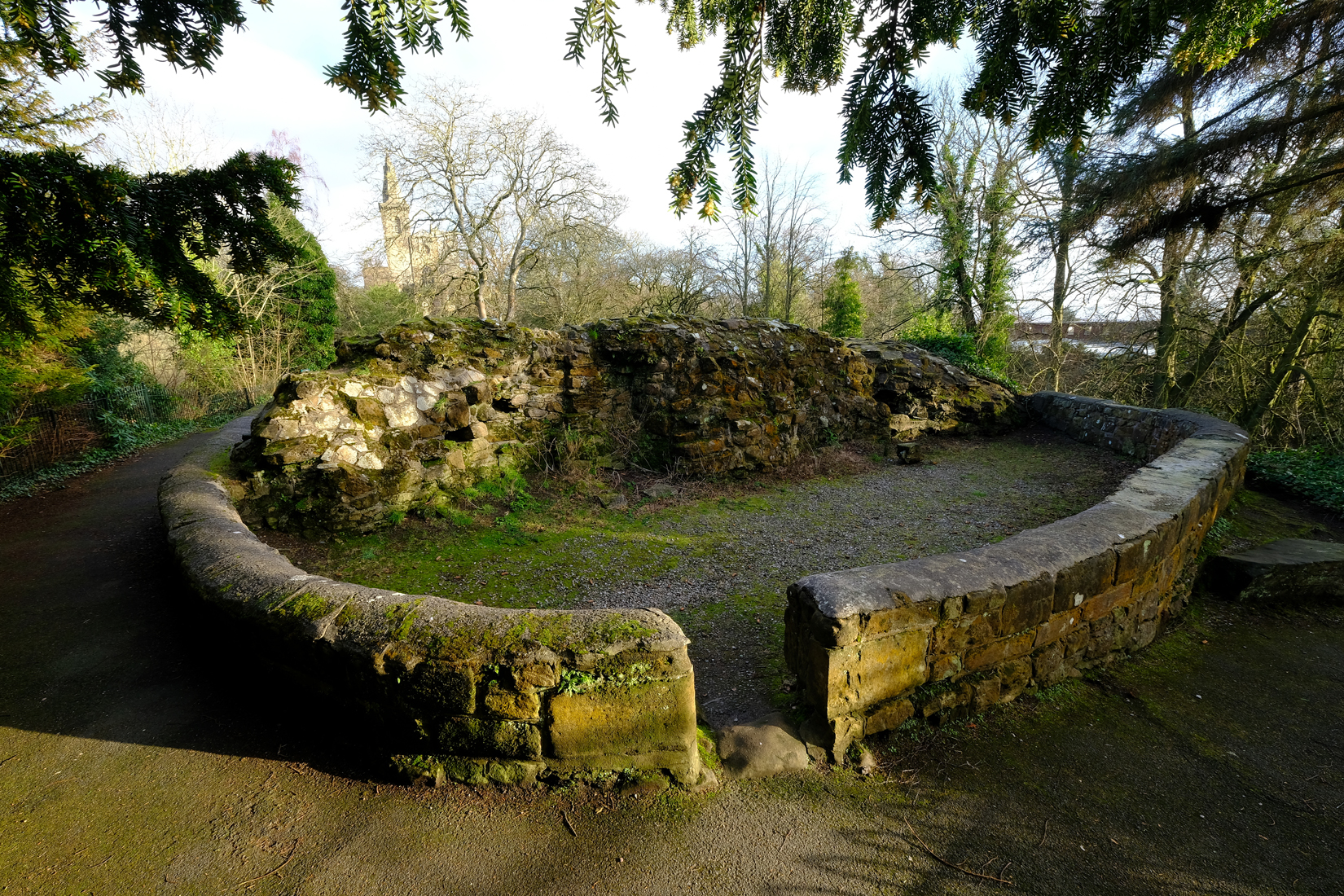Fiona: No. That did used to be a palace, but not until James VI (and James I of England of course) lived here with his family five hundred years later. Nearby though, we can see where local tradition says Malcolm’s Tower was. To find it, we have to go through these gates opposite the Abbey door, into the lovely Pittencrieff Park. If you prefer to avoid the steps then look to the right and leave the graveyard via the main gate and turn left onto the cobbled street to reach the Park gate. Follow the path down the slope then I hope you’re up for a bit of a climb. Look out for the plaque pointing you up the steps on the right.
Fiona: Now, you’re going to have to use your imagination a bit here. This may look uninspiring, and as I say, we don’t really know where their home was but let’s just imagine somewhere around here there was a rather grand place where the court lived when not out battling the neighbours. Malcolm probably didn’t have much in the way of cushions and soft furnishings but along comes Margaret and she definitely adds a pop of colour where she can!
Fiona: Well, what I mean is, it is said that Margaret was responsible for transforming day to day living at the palace and in the town because she was the first one to bring some of the finer things in life to the area. At the time, not even the church had much decoration or colour.
Fiona: Whether Malcolm’s tower was on this hill or not, he would definitely have chosen to put his court in a place that was safe and easy to defend, on high ground, surrounded by water. But he probably wasn’t too worried about the interior design!
Thomas: I’m struggling to imagine any sort of palace or house around here or near the church. How do we know about the things she is supposed to have introduced?
Fiona: Historians have disagreed over some of the stories that have been passed down over time. It was a long time ago after all. However, what is generally accepted is that there was a book written about Margaret by someone who knew her for real, a man called Turgot, who was the Bishop of St Andrews. Because many of the things he wrote about her were very detailed, it’s thought he probably knew her personally, maybe even have been her spiritual advisor. He couldn’t have known all the things he wrote about unless he lived in the court, at least for some of the time.
Fiona: One of the things he seems to imply is that Margaret was responsible for bringing quite some style and refinement to Dunfermline. In fact, it seems like he idolised his Queen and her taste and style.
(SFX Liturgical or courtly music, possibly Gregorian chant, or sounds of being in a church runs under Turgot’s words)
Turgot: “It was due to her that the merchants who came by land and sea from various countries brought along with them for sale different kinds of precious wares which until then were unknown in Scotland. And it was at her instigation that the natives of Scotland purchased from these traders clothing of various colours, with ornaments to wear; so that from this period through her suggestion, new costumes of different fashions were adopted the elegance of which made the wearers appear like a new race of beings.”
Fiona: Okay, his words are a bit old-fashioned, but I think he was saying she was an influencer of her time. Before she came along, people in the court or the wealthy houses of Scotland could only wear what they could make themselves. I suppose we’re talking a bit of sacking, in a varied palette of mud brown and gravel beige.
Thomas: Maybe the odd twig weaved through your hair on a Saturday night out.
Fiona: But for Margaret, she’s described as wearing richly embroidered and brightly dyed wool with a belt apparently ‘encrusted with jewels.’ I bet she turned heads. At the same time, she was fitting out the church with carvings, teaching her ladies to stitch intricate embroideries, and elaborately decorating the sacred books. And then suddenly the whole palace is eating off gold and silver plates too.
Thomas: Sounds like she wasn’t one to hold back. But where did these fine things come from?
Fiona: Well, that’s the thing. Until Margaret came and started demanding these ornate things, no one was bringing it here. The Queen comes along saying I want gold and wool and silk and some medieval self-starter thinks to himself, I’m going to make a nice profit here if I can get my hands on some of this stuff. Eventually word gets round that Dunfermline is a place where people have a taste of luxury and merchants realise they can get goods into the town because of the easy shipping access along the Forth. Before you know it, Dunfermline is the Metrocentre of the north.
Thomas: This sounds like THE place to be if you’re lucky enough to be wealthy, but what about this devout life she’s supposed to be leading? What about the rest of the people, stuck in their hovels, not getting much of a look-in at the high life?
